
Protuner tuning in practice
Case History 113, published two months ago described the theory behind the Protuner tuning methodology. But how well does it work in real life? This article describes just a few cases of the performance of real loops taken from various plants, and compares how they performed before with the as-found tuning, and then afterwards with Protuner analysis and tuning.
Example 1 – Settling time improved from 3 hours to 8 minutes
The first case is taken from a large chemical plant which required ‘tight’ level control (ie, keeping the level as closely as possible at set-point). Please note that the recordings shown are not the originals which are hard to read due to noise and other disturbances, so they have been ‘cleaned’ by putting them through an accurate simulation. However they reproduce faithfully what really did happen in the plant.
Apart from the tuning, no problems were found with the loop. The tuning parameters settings were: P = 1,5 and I = 8 minutes per repeat.
Figure 1 shows the closed loop ‘as-found’ test which was recorded over a 3 hour period. It can be seen how bad the response was to a 10% step change in set-point, being extremely slow and very cyclic. It had still not fully settled out at the end of the 3 hour period.
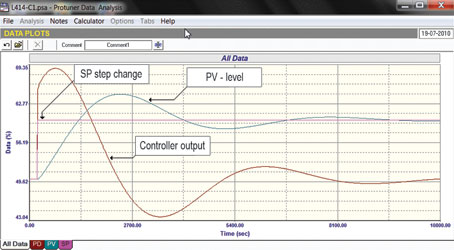
The Protuner tuning which was made from an open loop step change gave the following settings for a fast response: P = 12 and I = 12 minutes per repeat. The new response is shown in Figure 2. The PV reached the new set-point within 8 minutes, and had completely settled out a short while later.
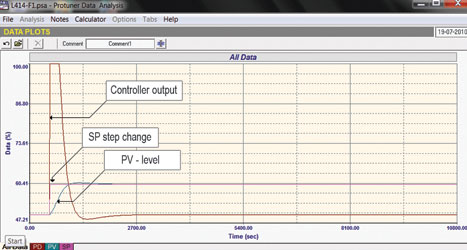
Example 2 – Variance transferred from output to input
A second example of how good the tuning is comes from a plant where I was performing optimisation at the time of writing this article. This was also a level control which is extremely important. The flow into the tank is highly variable. If the level drops too low, then the large pump that draws liquid out of the tank starts cavitating and wears out quickly. With the existing control the plant has been replacing pumps on a monthly and sometimes even a weekly basis. This has cost them an enormous amount of money!
The original as found tuning was: P = 3 and I = 600 seconds per repeat.
The Protuner tuning gave: P = 8 and I = 300 seconds per repeat.
Figure 3, taken from a report on the plant’s Process Plus continuous loop monitoring package, shows three recordings. The top and bottom tell the story.
The top one shows the level process variable. The left hand side is the control with the original tuning. The level fluctuates all over the place. It is no wonder that the pump was cavitating. The performance with new tuning is on the right. The incredible improvement in control can be seen. The level now stays within a really tight band.
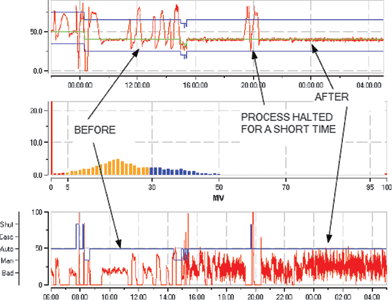
The bottom trace is that of the controller output. It can be seen on the right side that the valve is working much harder with the new tuning. This is to be expected. As mentioned in a recent Case History, all that one does with control is to transfer the variance from the one side of the process to the other, and this is what has happened here. Sometimes people say that you cannot let a valve work like that, and yes, the valve is going to wear out more quickly, but this is a case where the valve must be sacrificed for the control. Economically the valve will still last much longer than the pumps did, and is also much cheaper. This will save a lot of money over a year.
It works for temperature too
The next example of differences between original and Protuner tuning is of a critical and relatively slow temperature process in a chemical plant. The set-point of the controller comes from a higher level advanced control system. The process is also subject to frequent and fairly fast load disturbances. Poor performance severely jeopardises product quality. The operators were very unhappy with the performance of this important loop.
Figure 4 shows responses to set-point changes with the as-found tuning. It can be seen that the process takes a very long time to respond and is jumping around quite badly.
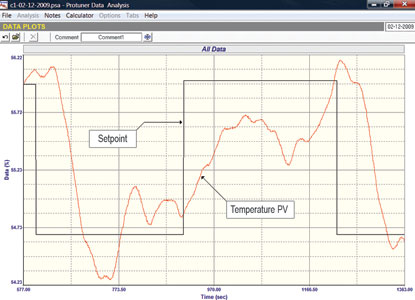
The original as found tuning was: P = 0,25, I = 0,7 minutes per repeat, and D = 0,2 minutes. A filter of 0,2 minutes was inserted in front of the process variable.
The Protuner tuning gave: P = 1,4 and I = 0,7 minutes per repeat. The D and filter were removed.
The resulting performance was brilliant as shown in Figure 5 which shows a long-term test recorded over 15 hours with the new Protuner tuning. (Please note that the scale of the recording is over a very small range of only 5%, so the traces are magnified considerably). During part of the period the set-point coming from the advanced control was changing. The temperature stayed with ±1,5°C in a measurement range of 0-225°C. As can be seen from the variations going on in the movements of the controller output, the tuning was coping brilliantly with load disturbances!
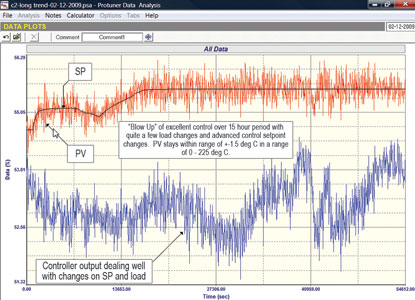
The problem with closed loop tuning
In the previous article, Case History 113, which described the Protuner’s tuning methodology, it was mentioned that Techmation does not recommend closed loop tuning for various reasons, including that it is difficult to get a truly representative sample of the process dynamics, especially when any valve problems exist. The next example illustrates this point perfectly.
Figure 6 is the recording of a set-point change made on a flow loop. The trace on the top (black) is the controller output. It can be seen that when the set-point was changed, how the flow stayed where it was. This was due to the valve sticking. After a small initial proportional jump, the output went into a constant ramp which was caused by the integral trying to get the valve to move. Eventually the valve broke free and the flow reached set-point, and shortly after that the valve jumped further up past set-point. The controller then started ramping back down to try and get the flow back down to set-point. After it had moved only a few percent the valve suddenly reversed and jumped back down way below set-point. The whole process then repeated a couple more times, and finally the flow did get to set-point.
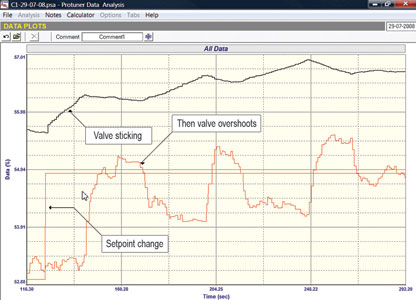
It can be seen from this that any tuning system that tried to use this response for tuning would be doomed to failure, as the responses are in no way related to the dynamics of the process. Admittedly, this is a bit of an extreme case. But when you take into account that at least 50% of control loops have problems, 80% generally due to valves, then you realise that tuning in automatic has very little chance of success.
There is no doubt at all in my mind that the only way to do tuning is to follow all the procedures to ensure that one does get a step truly representative of the process dynamics, and this is only generally possible by making step changes in manual. I also believe that if one is to succeed then you do need a proper tuning package like the Protuner, especially with complex process dynamics.
To cite a specific example: in an article recently published in Intech, the journal of the ISA, one of the world’s leading control experts stated that it is beyond the capability of most control practitioners to successfully tune most temperature loops by trial and error – it takes too long.
Successful optimisation needs in-depth understanding of practical control and the analytical and tuning tools necessary to carry it out.

Michael Brown is a specialist in control loop optimisation, with many years of experience in process control instrumentation. His main activities are consulting, and teaching practical control loop analysis and optimisation. He gives training courses which can be held in clients’ plants, where students can have the added benefit of practising on live loops. His work takes him to plants all over South Africa, and also to other countries. He can be contacted at Michael Brown Control Engineering, +27(0)11 486 0567, [email protected], www.controlloop.co.za
| Email: | [email protected] |
| www: | www.controlloop.co.za |
| Articles: | More information and articles about Michael Brown Control Engineering |

© Technews Publishing (Pty) Ltd | All Rights Reserved